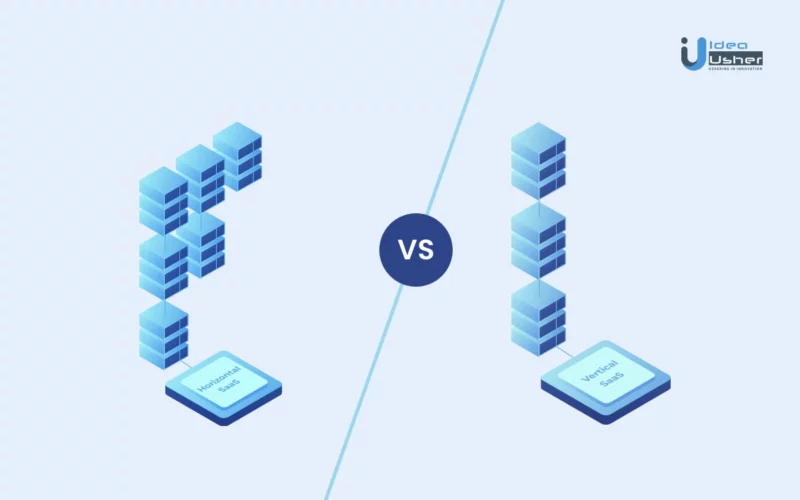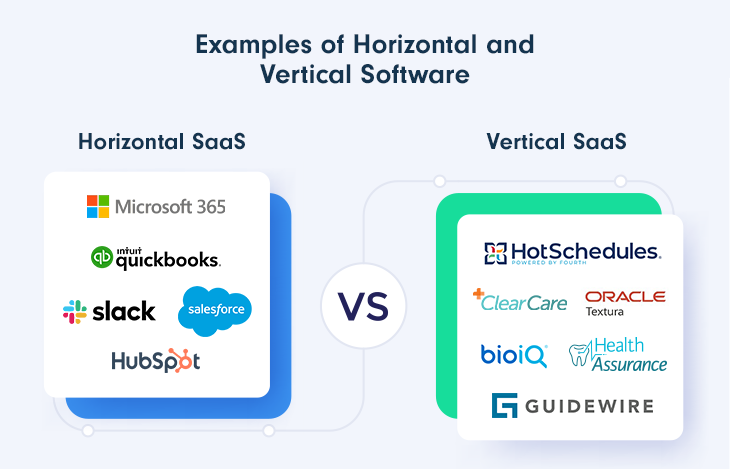
Table of Contents
SaaS businesses often follow a subscription-based business model in which customers pay a charge to access the software. As a result of shifting priorities, business models have evolved to accommodate the emergence of both vertical and horizontal SaaS enterprises. Consumers are now more knowledgeable about the various options available, and the market has reached a more mature stage and is prepared to receive new technological products and services like SaaS.
The SaaS sector is significant due to its affordability. Additionally, it benefits small businesses by giving them equitable subscription-based access to expensive, powerful, and effective software. Cloud computing is the way of the future, and SaaS is already one of the most important components of companies. It facilitates the achievement of higher and more steady income. Additionally, because SaaS integration enables businesses to automatically move information between apps as needed, a lot of organizations employ it to save time. After spending some time setting up the initial integration, everything is ready to go. Companies do not have to be concerned about manually entering data anymore.
This blog will assist you in distinguishing between Vertical SaaS and Horizontal SaaS by outlining the benefits, limitations, and other significant background information of each so you can determine which is best for your company.
Source:IdeaUsher
Horizontal SaaS
Cloud software solutions that cater to a broad spectrum of corporate users, irrespective of their industry, are known as horizontal SaaS. In terms of market share, horizontal SaaS solutions are more established than vertical ones, as the latter has been in use for more than ten years. Horizontal software prioritizes business needs over individual consumer ones due to its scale and economic strategy.
The goal of horizontal SaaS enterprises is to offer a comprehensive service that can span numerous industries and a large portion of the market. There are many different types of businesses in multiple industries that choose to use SaaS solutions, including the insurance industry, supply chains, retailers, and manufacturers. This lowers the cost of acquiring new customers for a horizontal SaaS company. Software developers and providers for a particular purpose utilized by businesses in all sectors make up horizontal SaaS organizations. Initially, the most prosperous venture-backed businesses employed a horizontal strategy when it came to SaaS business strategies. This approach was chosen since it allowed the business to reach the widest market possible.
HubSpot (marketing), Salesforce (CRM), and QuickBooks (accounting) are a few well-known instances of horizontal software as a service. A significant amount of resources and technologies, such as automated marketing emails, campaigns, and other inbound marketing tactics, may be needed for horizontal SaaS marketing and sales initiatives. It is likely that they are attempting to target several target populations separately by executing multiple marketing initiatives simultaneously. Making sure that their desired target audience can relate to something is one of Horizontal SaaS's primary objectives.
To delve a little further, the most well-known example of Horizontal Software as a Service is Salesforce, which provides CRM software for use by direct and indirect sales teams, independent of the goods or service the team is offering. Furthermore, because of their incredibly low cost of service and the minimal engineering support needed for simple, mature applications, low-cost SaaS options are highly profitable. In order to gain market share and develop their own premium solutions, new horizontal software as a service companies have to constantly fight with even more affordable alternatives. By 2020, there were very few chances for new entrants into the fully developed horizontal SaaS industry, which was characterized by huge rivals and commoditized services for every conceivable business and consumer function. Investors started to shift their focus to Vertical SaaS potential once the high growth phase of Horizontal SaaS had ended.
Horizontal SaaS solutions are universal and cater to general business needs, including internal company communication, even though they cover a wide range of niches. It is therefore anticipated that putting more of an emphasis on client success will increase horizontal software retention rates. Customers typically have a lot of options (many SaaS companies now offer project management solutions, for instance), thus their survival depends on drawing in more leads and keeping enough of "their" personnel. The obvious benefit of a horizontal SaaS is that it can target a far larger potential market. As opposed to companies that focus on a specific vertical, this indicates that there is greater space for various SaaS. The horizontal market will take longer to reach full saturation.
Source:PayPro Global Blog
Related Article: Top 15 AI Assistants to Boost Your Productivity in 2024
Vertical SaaS
Vertical SaaS solutions include software that is targeted to a particular niche or industry-specific standards. This tendency in the SaaS market's development is more recent, making it less established than the horizontal model. Indeed, a number of observers believe that because vertical SaaS providers are a relatively new phenomenon, there might be greater opportunity for them in the present day. Vertical SaaS companies do not want to offer a wide range of products or try to please people of all businesses. To explain, vertical software is far more focused on particular industry verticals. Vertical software reduces the extent of the possible market because it is specifically designed for distinct industry segments.
Software specifically designed for a particular sector is developed by vertical SaaS companies. These businesses developed later than horizontal SaaS businesses, but they are multiplying far more quickly in terms of both number and income. These businesses have a smaller Total Addressable Market opportunity due to their highly targeted software applications that are unique to each industry. Due to the increased complexity involved in digitizing particular industry functions, software development also requires a lot more resources. Existing functions tend to be more dated and specialized, are poorly understood outside of the industry, and are tailored to meet the needs of particular industries.
Some popular examples of Vertical SaaS are BioIQ (MedTech), Health Assurance Plan (dental software), and Guidewire (insurance). Vertical SaaS tools are created by professionals with knowledge of the particular industry they are intended for. For instance, a dentist office created the Health Assurance Plan first for its own usage. They found that it was so effective in their own practice that other people could also implement it. It provides dental coverage to people who are unable to buy insurance or do not have it as an option, which addresses a highly industry-specific issue. When it comes to marketing, the Vertical SaaS model is far more constrained than its horizontal equivalents. Because it's a narrow market with a single industry emphasis, this needs less resources.
An increasing number of vertical SaaS solutions target particular industries and seek to address issues specific to those businesses in light of the widespread trend of digitizing many, if not all, industries. Although the potential market and user base for vertical SaaS are smaller, the fact that it caters to a particular specialty typically ensures that the solution will best address a particular need.
One of the most noticeable issues with vertical SaaS companies is that many of them focus on particular industries that have conservative business practices or are in non-digital niches. They have their job cut out for them in convincing banks, insurance providers, building companies, manufacturing companies, and health specialists that it's time to abandon their conventional approaches. Vertical SaaS models provide a means for SaaS providers to delve deeply, provide specialized solutions that address the unique challenges of a certain vertical, and cultivate a devoted clientele. Since the market is still in its infancy, it is difficult to characterize any one vertical SaaS solution as "dominant" in any industry at this time.

Contrast
The breadth of the targeted industries and market size can be used to distinguish between Vertical SaaS and Horizontal SaaS. Vertical and horizontal SaaS solutions differ in the scope of their targeted industries and market size. Whereas horizontal SaaS offers solutions to a far wider population of potential consumers, vertical SaaS targets the needs of a particular group within a certain industry. Additionally, their approaches to marketing, user acquisition, and retention are frequently very different.
Next, the competition facing Vertical Saas and Horizontal Saas differs. To put it another way, horizontal SaaS solutions must work hard to set themselves apart from the competition and shine out as the greatest option among the numerous that are available. This is because they cater to a range of sectors. Customers can quickly evaluate their software against a wide range of other options and, if a better or more affordable one becomes available, transfer to it.
Conversely, vertical SaaS solutions have less competition and can more readily reach their clients because they concentrate on a certain industry or specialization. Naturally, there is less rivalry in user acquisition when there are fewer options for their products. Users of vertical SaaS solutions tend to stick with the software they use and are comfortable with, which helps them not only attract users more readily but also retain them.
Making a Selection
Consider the advantages and disadvantages of each SaaS type before deciding which one to choose. Here are some key questions you should ask yourself before making your final choice.
Related Article: Top 10 AI Assistants For Journalists in 2024
Marketing
Who is your intended market, and how will you implement your marketing strategy? How are you going to introduce your SaaS product to prospective customers?
Remember that your marketing approach will change based on whether you want to grow your company vertically or horizontally. You also need to ensure that you have enough marketing and sales personnel on staff before beginning the process of growing your business and drawing in new customers to your product. Your marketing and sales team must be well-versed in the industry and any issues that your users may encounter if you plan to grow vertically and focus on a particular area.
Differentiating component
How do you intend to differentiate yourself from the competition and position your SaaS product as the superior choice? What distinguishing features will convince potential customers to pick your product over a comparable alternative?
It will be considerably simpler for you to scale vertically if you have a compelling differentiator. The potential user base will recognize creative and unique solutions that address specific issues within a given industry. Strong marketing and sales teams that can communicate your message to potential customers will be needed for this.
Your team/staff
Do you have a capable group of people on your team who can assist you in growing your company? Can your developers put your concept into practice and ensure that it functions perfectly? Once you begin developing your company, you will undoubtedly have a rising user base. Do you have adequate team resources to keep up with this?
Customer Support and Success
How will you make sure your SaaS product users receive all the assistance they require once you've acquired their business? Do you have the resources and personnel to give your clients excellent support? How can you support the expansion of your clients' companies?

When determining whether you are ready to scale your SaaS company vertically or horizontally, there are a number of aspects to consider, as the examples above illustrate. The major difference between vertical and horizontal SaaS rests within the industry and the potential market they target. Businesses that employ vertical SaaS often target niche markets, have few competitors, and have an easier time gaining and keeping users. In contrast, businesses who choose horizontal SaaS have in mind that these services are utilized across a range of industries, face some fierce rivalry, and require more work to attract and keep users. If you choose one of the SaaS options, it will significantly affect your organization as a whole, so make sure you keep in mind to take many different aspects of your business into consideration and have a strong plan before putting it into action.
Sources
https://www.liquidweb.com/blog/vertical-saas-vs-horizontal-saas/
https://flgpartners.com/saas-industry-centric-business-models-horizontal-vertical/
https://www.koombea.com/blog/vertical-horizontal-saas/
https://blog.payproglobal.com/vertical-saas-vs-horizontal-saas
https://www.apptension.com/blog-posts/are-you-considering-vertical-and-horizontal-saas-as-a-consumer-or-creator


